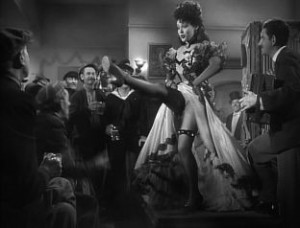It’s hard to watch, much less for a critic to review, a film when Herrmann is present and not mention the score. The redoubtable Bosley Crowther failed to do just that in 1960 in reviewing Psycho, which possesses one of the most devastating and original film scores ever conceived. It’s just as hard, here in Hangover Square, not to notice the music.
 Herrmann has it twice his way—a Gothic horror (he had just scored Jane Eyre) and a film about a classical musician. What more could he ask? But the Hangover Square music, as a score per se, isn’t as original as that for the Charlotte Brontë film, or for the two especially distinctive scores that would follow in a few years, The Ghost and Mrs. Muir and The Day the Earth Stood Still. Ghost is reputed to have been the composer’s favorite among his scores, as far from the tone and tincture of Hangover Square as conceivable.
Herrmann has it twice his way—a Gothic horror (he had just scored Jane Eyre) and a film about a classical musician. What more could he ask? But the Hangover Square music, as a score per se, isn’t as original as that for the Charlotte Brontë film, or for the two especially distinctive scores that would follow in a few years, The Ghost and Mrs. Muir and The Day the Earth Stood Still. Ghost is reputed to have been the composer’s favorite among his scores, as far from the tone and tincture of Hangover Square as conceivable.
It is when the bits and pieces from Hangover Square are assembled into Bone’s definitely macabre concerto that the music takes on its rewarding fascination—and its more than respectable rank alongside other famous cinematic “concertos”: Addinsell’s Warsaw, Rózsa’s Spellbound, Korngold’s Deception Cello Concerto, Bath’s Cornish Rhapsody and even Steiner’s misnamed Symphonie Moderne, certainly the slightest in this list.
At only seventy-seven minutes, Hangover Square is not the equal in production value of other 20th Century-Fox films of the time. Some of the sets, particularly Middleton’s office and the dance hall, seem on the cheap side. The film did not turn out as Cregar had hoped, though exactly what he was expecting is uncertain; perhaps a more literate script. Langan is reduced to just another suitor of Darnell, who, at first, didn’t think the role was appropriate for her. And Sanders refused to say what he considered some inane lines, costing time and money.
As for a disturbing—at least to me—anachronism, in Hangover Square 20th Century-Fox is trying to recreate the Victorian London of The Lodger, Cregar’s previous film, in which he may or may not be Jack the Ripper. Victoria had died in 1901, and for 1903 the set designers persist in using candles and gas, both existing in the same room; Bone lights a candle when on the wall behind him is a gas fixture, which he turns on in another scene! Central London, if I’m not mistaken, had electricity by the 1890s, certainly by 1903.
In one scene, three actors—Napier, Worlock and Sanders—are grouped around a frilly, dazzlingly bright fabric-covered lamp. True, the scene is replete with dramatic shadows, a film noir touch. But a question bears asking: What prevents the shade from bursting into equally dramatic flames, since the light source has to be a flame, as electricity has never been in evidence?
CFF, bravo for your detailed, compelling review of HANGOVER SQUARE, a film that’s always resonated with me. It may be a bit flawed, but Laird Cregar’s performance blends madness and poignancy very well, and makes me sad that he died so young and so senselessly. At the very last, it’s certainly an object lesson in why it’s unwise to go to drastic means for your art. HANGOVER SQUARE’s brooding, Victorian-inspired atmosphere strikes me as a sort of retro-noir. Great post!
Well done review. After reading so many poorly written posts by other so-called critics it is a pleasure to read one with depth and insight like yours. Thank you.